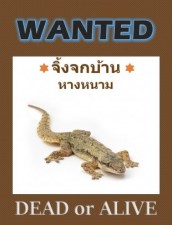จิ้งจกบ้านหางหนาม
จิ้งจกบ้าน หางหนาม
COMMON HOUSE GECKO
- ชื่อสามัญ : Common house gecko
- ชื่อวิทยาศาสตร์ : Hemidactylus frenatus
- Family : Gekkonidae
- Order : Squamata
ลักษณะทั่วไป
ตัวเต็มวัยมีขนาดลำตัวยาว 3-5 นิ้ว (7.5-15 cm.) มีสีน้ำตาลอ่อนจนถึงเข้ม ด้านข้างมีแถบสีดำยาวจากจมูกถึงลำตัว หางกลม มีหนามอยู่ด้านข้าง ส่วนท้องมีสีขาว เท้าคู่หน้ามี 5 นิ้ว ส่วนเท้าคู่หลังมี 4 นิ้ว บริเวณฝ่าเท้ามีปุ่มดูด (toe pads) ทำให้สามารถดูดติดกับผนังได้ บริเวณด้านใต้คางมีเกล็ดเรียบอยู่ติดกับปาก (infralabials) และเกล็ดด้านใน 2 คู่ (chin shields) อาจมีตุ่มขนาดเล็ก (tubercles) กระจายอยู่ด้านหลัง ส่วนหางสามารถงอกใหม่ได้ ใช้เวลา 2-6 สัปดาห์
จิ้งจกบ้านมีการเจริญเติบโตแบบ (Ametamorphosis) คือไม่มีการเปลี่ยนแปลงรูปร่าง ตัวอ่อนมีลักษณะเหมือนตัวเต็มวัย เพียงแต่มีขนาดเล็กกว่า
- ระยะไข่ (Egg) : มีระยะเวลา 22-68 วัน (เฉลี่ย = 56 วัน) ตัวเมียวางไข่ตามซอกหลืบ เป็นไข่ที่มีเปลือกหนาและไม่ยึดติดกับพื้นผิว ครั้งละ 2 ฟอง กว้าง 5-9 mm. ยาว 6-10 mm. มีสีขาวคล้ายไข่เป็ด การผสมพันธุ์เกิดขึ้นบ่อยที่สุดระหว่างเดือนสิงหาคมถึงธันวาคม แต่สามารถผสมพันธุ์ได้ตลอดทั้งปี
- ตัวอ่อน (Juvenile) : ลักษณะเหมือนตัวเต็มวัย แต่มีขนาดเล็กกว่า
- ตัวเต็มวัย (Adult) : มีอายุขัยประมาณ 3-5 ปี
พฤติกรรม : มีพฤติกรรมหวงอาณาเขต เมื่อพบสายพันธุ์เดียวกันรุกล้ำอาณาเขตจะแสดงพฤติกรรมก้าวร้าวออกมามากกว่าจิ้งจกชนิดอื่น หาดเกิดการกัดหรือต่อสู้ มักจะนำไปสู่การสูญเสียหางหรือเกิดแผลเป็น อย่างไรก็ตามจิ้งจกชนิดนี้ไม่มีพิษและไม่เป็นอันตรายต่อมนุษย์ กัดไม่เข้าผิวหนัง
แหล่งอาหาร : แมลงตั้งแต่ขนาดเล็กจนถึงใหญ่และแมงมุม
แหล่งอาศัย : ชอบสภาพแวดล้อมตามบ้านเรือน อยู่ในซอก หรือรอยแตก หากไม่อยู่ตามบ้านเรือนจะอยู่ตามป่าที่มีลักษณะคล้ายป่าทึบ
การแพร่กระจาย : มีถิ่นกำเนิดในเอเชียตะวันออกเฉียงใต้ ปัจจุบันแพร่กระจายในหลายประเทศทั่วโลก
การนำโรค : ในลำไส้ของจิ้งจกมีเชื้อซาลโมเนลลา (Salmonellasp.) ซึ่งเชื้อแบคทีเรียนี้จะปะปนมากับมูลหรือของเสียที่ขับออกมาจากร่างกาย หากเผลอไปรับประทานอาหารหรือน้ำที่ปนเปื้อนมูลที่มีเชื้อซาลโมเนลลา ผู้ที่มีอายุต่ำกว่า 5 ปี และอายุมากกว่า 65 ปี หรือผู้ที่มีภูมิคุ้มกันบกพร่อง รวมถึงหญิงตั้งครรภ์ ควรหลีกเลี่ยงการสัมผัสทั้งทางตรงและทางอ้อม
*เชื้อซาลโมเนลลา (Salmonella sp.) เป็นเชื้อแบคทีเรียก่อโรคที่สำคัญของมนุษย์ ผู้ป่วยที่ได้รับเชื้อเข้าไปจะทำให้เป็นโรค Salmonellosis ทำให้มีอาการเป็นไข้ ท้องร่วง หรือท้องเสีย SOURCE: A study on the presence of Salmonella spp. in house geckos (Hemidactylus frenatus) https://www.researchgate.net/publication/257310675_A_study_on_the_presence_of_Salmonella_spp_in_house_geckos_Hemidactylus_frenatus
เอกสารอ้างอิง
Köhler G, 2003. Reptiles of Central America. Offenbach: Herpeton
Carranza S, Arnold EN, 2006. Systematics, biogeography, and evolution of Hemidactylus geckos (Reptilia: Gekkonidae) elucidated using mitochondrial DNA sequences. Molecular Phylogenetics and Evolution, 38:531-545
Krysko KL, Daniels KJ, 2005. A key to the geckos (Sauria: Gekkonidae) of Florida. Caribbean Journal of Science, 41:28-36
Zug GR, Vindum JV, Koo MS, 2007. Burmese Hemidactylus (Reptilia, Squamata, Gekkonidae): taxonomic notes on tropical Asian Hemidactylus. Proceedings of the California Academy of Sciences, 58:391-408
Cook, Robert A. 1990 Range extension of the Darwin house gecko, Hemidactylus frenatus. Herpetofauna (Sydney) 20 (1): 23-27
Darevsky I S; Kupriyanova L A; Roshchin V V 1984 A new all-female triploid species of gecko and karyological data on the bisexual Hemidactylus frenatus from Vietnam. Journal of Herpetology 18 (3) : 277-284
Edgren, Richard A. 1950 Notes on the Neotropical population of Hemidactylus frenatus Schlegel Natural History Miscellanea (55): 1-3
Keim, Lauren (2002). The spatial distribution of the introduced Asian House Gecko (Hemidactylus frenatus) across suburban/forest edges (BSc Honors thesis). Unpublished Honours Thesis, Department of Zoology and Entomology, the University of Queensland.
Newbery, Brock; Jones, Darryl N. (2007). Lunney, Daniel (ed.). Presence of Asian House Gecko Hemidactylus frenatus across an urban gradient in Brisbane: influence of habitat and potential for impact on native gecko species. Pest or Guest: The Zoology of Overabundance. Royal Zoological Society of New South Wales. pp. 59–65.
Marcellini, Dale (1971). "Activity Patterns of the Gecko Hemidactylus frenatus". Copeia. 1971 (4): 631–635.
McKay, J. Lindley; Griffiths, Anthony D.; Crase, Beth (December 2009). "Distribution and habitat Use by Hemidactylus frenatus Duméril and Bibron (Gekkonidae) in the Northern Territory, Australia". The Beagle: Records of the Museums and Art Galleries of the Northern Territory. 25: 111–116.
Gallina-Tessaro, Patricia; Ortega-Rubio, Alfredo; Alvarez-Cardenas, Sergio; Arnaud, Gustavo (1998). "Colonization of Socorro Island (Mexico), by the tropical house gecko Hemidactylus frenatus (Squamata:Gekkonidae)". Review of Tropical Biology. 47: 237–238.
Ota, H. 1936. Hemidactylus okinawensis OKADA. Journal of Herpetology, 23/4: 444-445.
Department of Agriculture and Fisheries: Biosecurity Queensland. Asian House Gecko. Australia: State of Queensland. 2016.
Arnafia W., Ningrum S. G., Adji R. S., Lukman D. W., Pasaribu F. H., Wibawan I. W. T.2016. Isolation of Salmonella from reptiles in pet shop and its susceptibility to antibiotics in Indonesia. H.V.M. Bioflux Scociety 8: 177–181.
Cheng B. Y., Siew P. W., Gary A. D.2014. Salmonella associated with captive and wild lizards in Malaysia. Herpetol. Notes 7: 145–147.
Anjos, L., C. Rocha. 2008. Reproductive ecology of the invader species gekkonid lizard Hemidactylus mabouia in an area of southeastern Brazil. Iheringia. Série Zoologia, 98/2: 205-209.
Myeres, G. 1945. A natural habitat of the house gecko in Brazil. Copeia, 1945/2: 120.
Rocha, C., L. Anos. 2007. Feeding ecology of a nocturnal invasive alien lizard species, Hemidactylus mabouia Moreau de Jonnès, 1818 (Gekkonidae), living in an outcrop rocky area in southeastern Brazil. Brazilian Journal of Biology, 67/3: 485-491.
......................................................................................................
*** สอบถามข้อมูลเพิ่มเติม ***
Tel : 02-374-7118-9, 02-377-2488, 02-377-9580, 02-375-1995
e-mail : customercare@unicorgroup.com
website : www.unicorgroup.com







